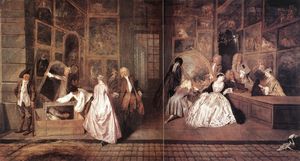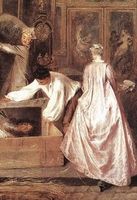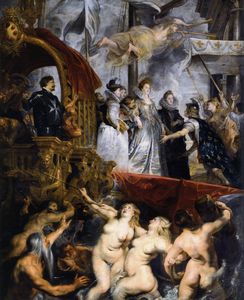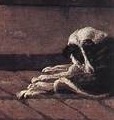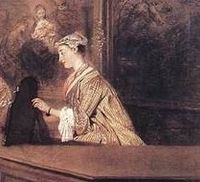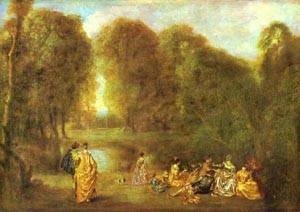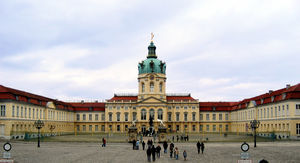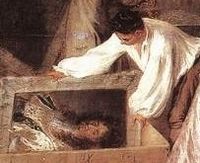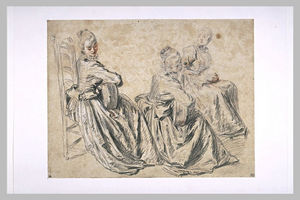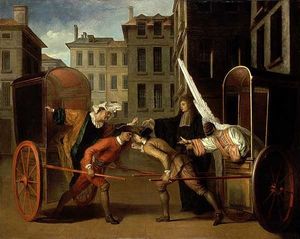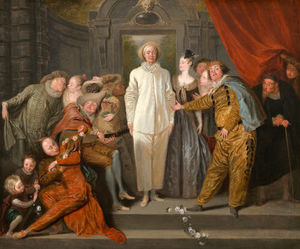L'Enseigne de Gersaint
- Date of Creation:
- 1721
- Height (cm):
- 163.00
- Length (cm):
- 308.00
- Medium:
- Oil
- Support:
- Canvas
- Subject:
- Scenery
- Art Movement:
- Rococo
- Created by:
- Current Location:
- Berlin, Germany
- Displayed at:
- Charlottenburg Palace
- Owner:
- Charlottenburg Palace
- L'Enseigne de Gersaint Page's Content
- Story / Theme
- Inspirations for the Work
- Analysis
- Related Paintings
- Locations Through Time - Notable Sales
- Artist
- Art Period
- Bibliography
L'Enseigne de Gersaint Story / Theme
Watteau's stay in the home of friend Edme-Francois Gersaint inspired L'Enseigne de Gersaint (the interior of Gersaint) and the theme very much centers on the sale of art.
Watteau approached this final masterpiece very differently than his other works. He normally painted slowly, but the last painting he would leave to the world would be the exception.
Perhaps Watteau's deteriorating health sped up the process, enabling him to complete a piece much larger than he normally painted in a miraculous eight days.
Watteau desired to paint a signboard of the interior of Gersaint's impressive gallery to ease the numbing effects his illness brought to his fingers. It would hang just beneath the sign of the name of the gallery.
Within the painted gallery, several elite individuals who purchase art are unaffected by the mysteriously disappearing façade and are more preoccupied in attaining their desired pieces. The workers of the gallery put the purchased art in boxes while a dog sleeps in the corner.
Though this piece is not a precise depiction of Gersaint's gallery, it provides viewers with insight into the elite establishment of a robust and thriving French gallery.
It captures the high class clientele and the thriving trade that made the art emporium a vital part of the 18th century French art market.
L'Enseigne de Gersaint Inspirations for the Work
Besides the aching numbness Watteau experience in his fingers due to ill health, he drew from the interior of his friend's art gallery. Gersaint was a successful art dealer, and a kind friend who opened his home to Watteau.
Interiors of picture galleries were a popular subject for enlightened art collectors and served as a record of identification. Though L'Enseigne de Gersaint may not truly depict Gersaint's interior, one can still admire the art seller's choices in paintings, two of which possibly belong to Ricci or Rubens. Rubens was a master Baroque painter whom Watteau studied very closely, especially his Medici series.
L'Enseigne de Gersaint Analysis
Watteau's intent for L'Enseigne de Gersaint, besides promoting art sales, focused mainly on personal growth and the satisfaction that came along with such success. Watteau had valued his drawings more highly than his paintings and was continually frustrated that he could not capture this quality in paint.
But as one can see in L'Enseigne de Gersaint, there is a naturalness to his figures that isn't seen in his earlier paintings. This piece was liberation for Watteau; in his last piece, he finally achieved one his most important aims.
Composition:
The viewer looks at the twelve figures from a head-on perspective. Watteau divides the twelve into two separate groups which made it possible to separate the painting into two parts.
He fills the majority of the foreground with the paintings of Gersaint's gallery. There is, however, a pooch in the lower right hand corner that sleeps in the dreamy shadows only Watteau could create.
Tone:
The mood of this piece illustrates the grandness and excitement of buying art. The women dress in fancy clothes, as eager to purchase art as they may be to attend a royal Ball.
Their male counterparts are dressed equally as fine, their wardrobe's suggesting how seriously they were about the sale. Watteau suggests such an event as a social get together.
Brushstrokes:
The effectiveness of the lighting in this piece was achieved through the artist's light and rapid brushstroke.
Color palette:
Though the grandeur of his landscapes is missing in this painting, the coloring of this piece is just as fascinating. The cool colors of the women's silk dresses serve as a wonderful contrast to the otherwise neutral, warm palette.
Lighting:
As one pays attention to the courting between the shadow and the light of the silk dresses, it is hard to believe that any artist could complete such a complicated fabric in just eight days.
Watteau's skill with the treatment of light created the form of the figure that he so badly wanted to translate from his drawings into his paintings. The dim interior of the gallery makes the silk stand out even more, and one can imagine how the shadows danced toward the light as the ladies moved around to view the art on display.
L'Enseigne de Gersaint Related Paintings
L'Enseigne de Gersaint Locations Through Time - Notable Sales
The signboard was an instant success, selling just a few weeks after it was posted. The sign was split in half and purchased by two different buyers but today back together as one piece, although a few inches are missing down the center. It currently resides in Charlottenburg Palace, Berlin.
L'Enseigne de Gersaint Artist
-

L'Enseigne de Gersaint
-

Study of a Woman Playing the Guitar or Holding a Musical Score
Critics have challenged Watteau's stylistic ability accusing him of being "deficient in the art of composition" and that he had yet to conquer relating figures in depth. In his larger works, groups are often painted in rows, as seen in L'Enseigne de Gersaint. Only in his smaller works are the figures in the same plane.
Critics also note that Watteau did not see in flowing curves but in tight, straight lines when it came to form. The substructure of even his quick sketches is severe.
Rectilinear severity in L'Enseigne de Gersaint is displayed with the standing lady and the kneeling connoisseur severity. All the figures, except the packer in the white shirt, have an underlying sharpness of accent.
Yet, despite this, Watteau is said to have extended the bounds of the 18th century French-born Rococo art period beyond architecture, furniture and sculpture and into painting.
He was attributed to developing a unique style and revolutionizing the art world through his individuality. This was seen not only in the themes of his work (very theatrically influenced) but also in his style (ornate, airy).
L'Enseigne de Gersaint Art Period
Watteau was a key player in the 18th century Rococo art movement. The word Rococo is a combination of the French rocaille, or shell, due to the heavy usage of shell-like curves, and the Italian barocco, or Baroque style for its decorative nature.
Its style emergence was first displayed in the decorative arts and interior design before Watteau adapted it toward painting aesthetics. Louis XV's succession brought a change in the court artists and general artistic fashion.
By the end of the old king's reign, rich Baroque designs were giving way to lighter elements with more curves and natural patterns. These elements are obvious in the architectural designs of Nicolas Pineau.
During the Régence, court life moved away from Versailles and this artistic change became well established, first in the royal palace and then throughout French high society. The delicacy and playfulness of Rococo designs is often seen as perfectly in tune with the excesses of Louis XV's regime.
Rococo painting, as well as most French art of the 18th century was light, airy, frilly and bejeweled, which is fitting as it was intended for the powerful aristocracy and wealthy upper-middle class.
Watteau's artistic content could be summarized by two major influences: his love for the theater and his fascination of the Rococo styling and design.
Spending his early years in Paris in the workshop of set designer Claude Gillot, Watteau gained his love for the theater, specifically for the Italian Commedia dell'Arte and its innumerable characters. Shortly after, he worked for interior designer Claude Audran III and picked up Rococo design influences.
Watteau's attraction to Rococo's curving lines and decorative nature became central to his later work. As his career progressed the artist combined his love for the theater and his fascination of the Rococo styling and design and developed a truly unique style of painting with ornate elegance that gained him critical attention.
L'Enseigne de Gersaint Bibliography
To find out more about Watteau and his works please choose from the following recommended sources.
• Lauterbach, Iris. Antoine Watteau: 1684-1721. PLACE, 2008
• Mollett, John William. Watteau. Kessinger Publishing, LLC, 2007
• Perl, Jed. Antoine's Alphabet: Watteau and His World. Random House, 2008
• Posner, Donald. Antoine Watteau. Cornell University Press, 1984
• Rogers, Robert Emmons. Behind A Watteau Picture: A Fantasy in Verse in One Act. Kessinger Publishing, LLC, 2007
• Sheriff, Mary D. Antoine Watteau: Perspectives on the Artist and the Culture of His Time. University of Delaware Press, 2006
• Stranahan, C. H. A History of French Painting From the Earliest To Its Latest Practice. Charles Scribner's Sons, 1918
• Zeri, Federico. Watteau: The Embarkation for Cythera. NDE Publishing, 2000

